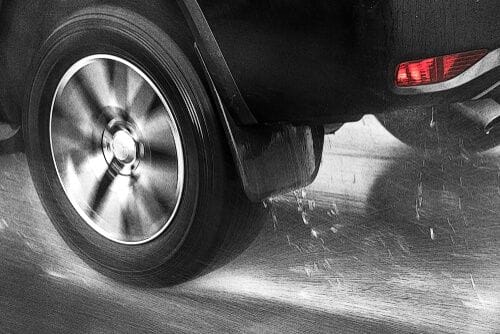Have you ever approached a corner on the road and found that the car isn’t turning as sharply as you would expect it to?
Or
perhaps you’ve been in a situation where the back of the car has kicked out and you’ve found yourself rotating too much?
These situations are known as understeer and oversteer, and they can happen in any car. There are many reasons why these situations can occur, and in most cases, if uncontrolled, they can be quite dangerous. It’s therefore important that people know what causes these events to happen, and how best to get back in control of the car for a safe outcome.
To know how to avoid them, we must first know exactly what understeer and oversteer are.

What is understeer?
The Basics of Understeer
Understeer occurs when the front wheels lose traction during a turn. So you may be turning the steering wheel left or right, and yet your forward momentum is causing the car to be unable to turn fully in the direction that the front wheels are pointing.
Understeer Culprits: Speed, Slippery Conditions, and Tire Health
This loss of traction can have a few potential causes:
1.Speeding into the corner
When you approach a corner, the momentum of the car makes it want to continue to travel in a straight line. It’s up to the front tyres to grip the road surface and move the car in the direction that they’re pointing. If you’re travelling too fast into the corner, the front tyres may lose that grip and therefore fail to steer the car’s momentum in the direction you intended.
2. Wet or slippery roads
When the road is wet or greasy, there is less available grip between the tyres and the road. This means your turning speed will need to be slower to avoid losing traction. Extreme wet conditions can cause not only diminished turning ability, but complete loss of control if the car ends up aquaplaning.
3. Worn-out tyres
It should go without saying, but your ability to control the car depends on the condition of your tyres. If they’re in good condition and have plenty of tread, then you’ll likely avoid the above situations if you’re driving responsibly. However, if your tyres are in poor condition, then their ability to maintain grip will reduce as they become more worn. Your car’s entry speed will therefore have to get slower and slower to compensate for the lack of grip from the worsening state of the rubber on your wheels.
The consequences of understeer can range from a missed turn to a serious accident, depending on the road conditions and your speed. To stay safe, learn to recognise your car’s handling limits and adjust your driving accordingly.
What is oversteer?

The Basics of Oversteer
Oversteer occurs when the rear tyres lose traction around a corner and the car begins to spin out of control. As the car over-rotates, the driver is likely to struggle to regain traction, leading to the car spinning out. If the car does regain traction, it’s common for this to occur at a point where the driver instinctively applies steering lock in the opposite direction, and so the car will ‘snap’ back and lurch the other way. Either way, the car has lost control, and depending on the circumstances, you may end up in a very dangerous situation.
Causes of Oversteer
The causes are the same as with understeer, except applied to the rear tires instead of the front. This means that front-wheel drive cars, rear-wheel drive cars and all-wheel drive cars can all experience this scenario. There is an additional factor when it comes to oversteer, though.
Drifting
Rear-wheel drive and four-wheel drive cars are also capable of losing rear traction not due to the above three situations, but because too much power has been applied to the back wheels. If there is any steering angle to the left or right at the time the rear wheels have lost grip and are now spinning freely, the car will experience lateral acceleration and begin to oversteer or ‘drift’. This can be a popular manoeuvre on track day, but is otherwise very dangerous on the road—not to mention illegal. To pull off a successful drift requires a very high level of throttle and steering control, and is why we see too many people ending up mounting the curb and even ending up in oncoming traffic.
How to regain control
In the case of an accidental drift, the trick is to keep the steering wheel pointing in the direction of the road ahead, which means as your car oversteers, your steering input will be against the direction of the spin. As the car straightens up you can release the throttle to regain traction. Lift the throttle too early and the car will suddenly lurch in the other direction and you’ll lose control, lift it too late and you’ll have begun another oversteer.
If you find yourself in an understeer situation, or an oversteer caused by points one, two or three, you’ll need to lift your foot off the throttle and gently scrub your speed. Brakes can be applied gently, but if you brake too hard you risk a lock up which will remove any control you had of the vehicle. Modern cars generally have electronic stability control which helps to mitigate this risk, but if possible, it’s best to regain control of the car yourself, rather than relying on electronic driving aids.
Prevention is the Best Medicine: Safe Driving and Car Maintenance

Drive Responsibly and Adapt to Conditions
Responsible driving plays a vital role in avoiding understeer and oversteer. Be mindful of your speed, especially when approaching corners, and adjust your driving style to suit the road conditions. When faced with wet or slippery surfaces, slow down and increase your following distance to give yourself extra time to react to unexpected events.
By understanding the causes of understeer and oversteer and how to regain control in such situations, you’ll be better equipped to handle your car safely and confidently on the road. Remember, prevention is key: keep your car well-maintained and practice responsible driving habits to minimise the risk of encountering these challenges in the first place.
Keep Your Car in Top Shape
One of the most effective ways to prevent understeer and oversteer is by keeping your car well-maintained. If your steering balance is off, your suspension is damaged, or your car’s differential isn’t functioning correctly, you’re more likely to encounter these situations. Safety starts with proper servicing, so to make sure your car is in the best possible shape to avoid a dangerous understeer or oversteer situation.
Service your car with Perth City Skoda to guarantee your car is in the best shape possible to handle whatever is thrown it’s way. Book your Perth City Skoda Service today and experience the difference.







